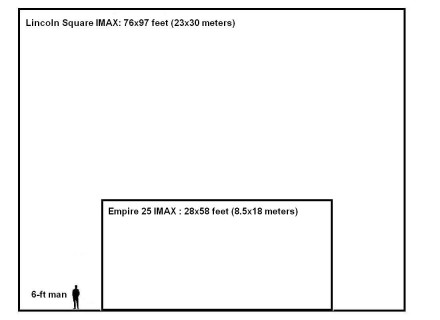How The Transformers: Revenge Of The Fallen IMAX Experience Compares With The Dark Knight
Last summer, Christopher Nolan wowed IMAX audiences by shooting the establishing shots and several action sequences of The Dark Knight in IMAX. Many were concerned that the effect would be jarring: Since only a few sequences were shot in IMAX, the picture would have to switch back and forth between a widescreen presentation and a native 70mm IMAX presentation (which filled up the entire whole, square-shaped frame).

Nonetheless, in the context of the film, these swaps made sense. The resulting establishing shots gave Gotham city a feeling of grandeur and openness unique to the IMAX format. The action scenes, already visually spectacular, took on a heightened immediacy and drama.
That's why I was excited to hear that the Transformers: Revenge of the Fallen would feature four scenes shot in native IMAX, and that the IMAX version of the film would be slightly longer with more robot fighting. Would the IMAX presentation enhance the film, as it did for The Dark Knight? Read onwards to learn what to expect when you walk into that enormous IMAX theater this weekend.
[By necessity, this article will contain MINOR spoilers about some sequences towards the end of the film. You have been warned.]
Let's get one thing out of the way quickly: While I was not a fan of the movie, the native IMAX shots in Transformers do in fact feature gigantic robots fighting, and they look spectacular. According to information released by the studio, the scenes in IMAX took as long as 72 hours per frame to render, but you can see every bit of detail and care that went into the film up on the screen. Optimus Prime apparently appears life-size in some of the scenes and while I can't vouch for the scale, I can say that it is impressive to behold. Nothing in this article should be interpreted as minimizing the achievements of the good folks at Industrial Light and Magic.
But here's the biggest difference between The Dark Knight and Transformers: Revenge of the Fallen: In The Dark Knight, entire sequences were presented continuously in native IMAX (e.g. the bank robbery scene at the beginning, the police car chase with the truck, etc.). The feeling you get is that from the outset, these scenes were carefully conceived and shot, so that the sequences would take full advantage of the IMAX format. The same is not true of Transformers.
By my estimation, the two most notable uses of IMAX occur in the middle of the film, during a thrilling forest fight between Optimus Prime and some decepticons, and at the end of the film, as Devastator and the Fallen are getting ready to activate their pyramidal device. You get a hint that this IMAX experience won't be as cohesive as what you might expect when the film begins cutting back and forth between native IMAX and widescreen during the fight itself. However, there still appears to be some sense of order to this: most of the scenes that take place in the forest appear in native IMAX, whereas some of the non-forest cutaways (e.g. a shot of the autobots rushing to Optimus' rescue, a short shot of the Fallen) are in widescreen. This fight scene is probably the highlight of the film and the IMAX element of it really adds to its visual impact.

Unfortunately, the problems with format switching are intensified for the film's closing minutes, during the Devastator/Fallen scenes. The frequency of switching between native IMAX and widescreen rapidly intensifies to the point of unpredictability, as one shot is presented in native IMAX while the very next shot, which occurs on the same location and as part of the same scene, is in widescreen. With Michael Bay's signature quick-cutting in full effect, it can be a jarring experience (the friend I saw the film with said he also found this switching back and forth to be occasionally distracting). Perhaps more puzzling is the fact that the shots one would expect to be in native IMAX (e.g. the final boss fight, the beautiful and massive explosion that takes place during the air strike) are not. Again, the shots in native IMAX featuring enormous machines doing battle are a visual wonder, but as whole scenes, these final parts of the movie fail to knock it out of the park.
In short, it feels when they were conceiving, planning, and storyboarding scenes for The Dark Knight, IMAX (and all the proceses that go into shooting a sequence in IMAX) played a central part of the process; for Transformers, it feels very unplanned and poorly thought out, as the appearance of IMAX shots near the end of the film occurs seemingly randomly. Granted, The Dark Knight did not have to contend with enormous CGI robots, but ultimately, I find it hard to rise to the defense of Transformers, which is such a bloated, incoherent, slapdash mess that it sadly comes as no surprise to me the film wasn't planned to the final detail.
[Image via Flickr user semuthutan]
